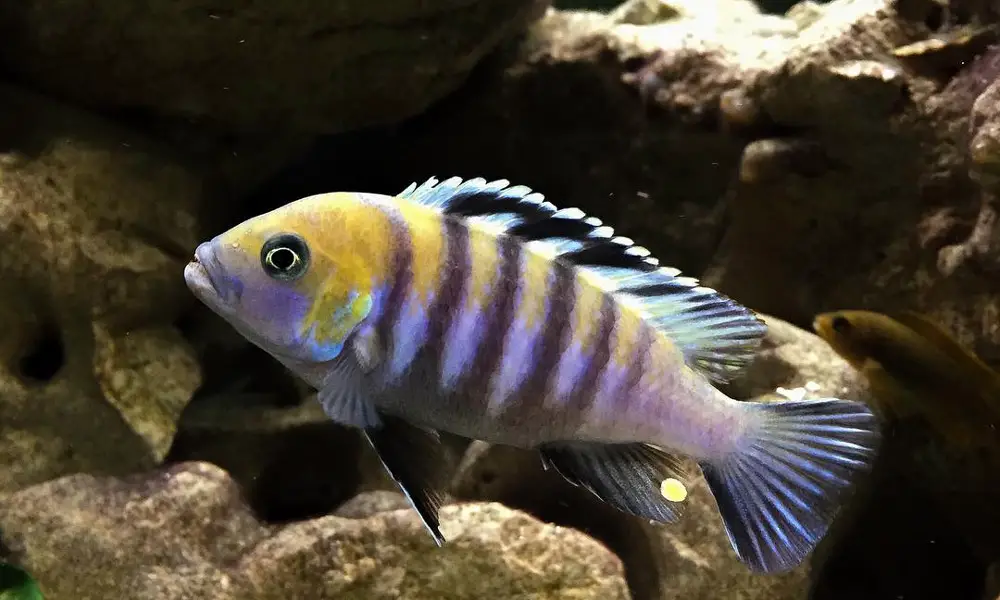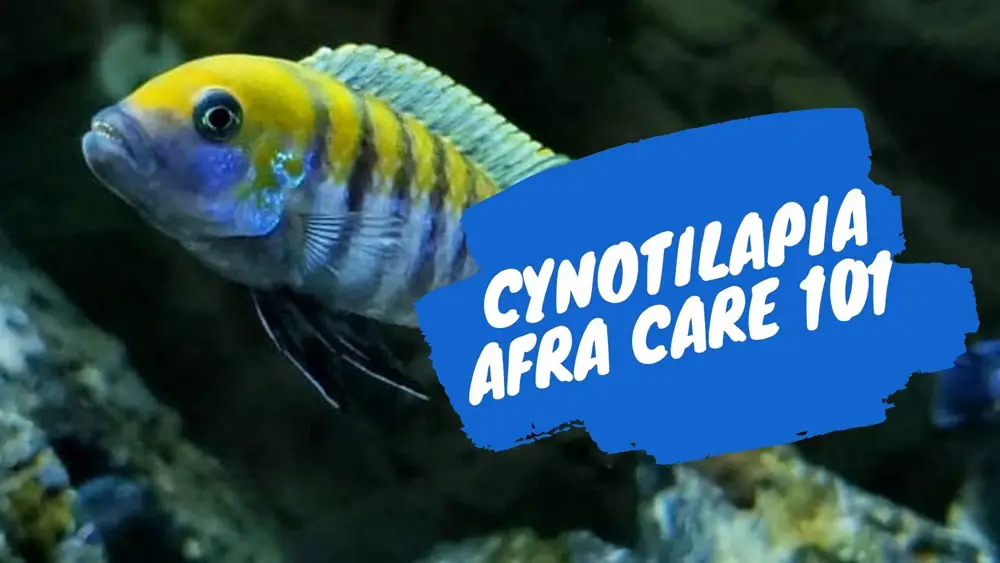The dogtooth cichlid (Cynotilapia afra), also known Afra Cichlid, is a fascinating Malawi fish among fish keepers because its beautiful color patterns. They’re much more than just colorful creatures- their size and personality make them fantastic for any mbuna tank too!
With their aggressive nature and susceptibility to Malawi bloat, it’s not always easy to keep these fish in a community setting. They need special care and can be more difficult than other species.
Whether you’re just getting started or want to expand your cichlid collection, this guide makes everything easy. It covers the essentials of Cynotilapia afra care such as size, tank mates, food, breeding, and more!
Let’s get going, then!
Species Summary

Sometimes referred to as the Afra Cichlid, Red Top Afra, or White Top Afra, the Dogtooth Cichlid (Cynotilapia afra) is a small Malawi mbuna that originates from rocky areas in Lake Malawi, Africa.
Like other African cichlids, this fish has many wonderful qualities, but as its name suggests, it is identified and distinguished by its unique unicuspid teeth.
Dogtooth Cichlids have a lot going for them; with its eye-catching appearance, it’s not hard to see why!
Dogtooth Cichlid Lifespan
In captivity, the average lifespan of a Dogtooth cichlid is between 7 and 10 years.
However, they will experience stress and disease without proper care, which significantly shortens their lifespan.
To ensure they have a long and happy life, you must be very mindful about tank maintenance and provide a healthy diet (more on that later).
Appearance & Popular Colors
The Dogtooth Cichlid is a fascinating fish that comes in many variations depending on where it’s from and what moods they’re feeling. The “excited” spawner coloration can be very intense, making for an interesting display that’s not to be missed!
You’ll come across a different coloration pattern of the Afra Cichlid, there are 18 different variations (Chewere, Chinuni, Chitande, Chuanga, Cobue, Jalo Reef, Likoma, Lumbila, Lundu, Lupingu, Mbenji, Metangula, Minos Reef, Msobo, Ndumbi, Njambe, Nkhata Bay, and the Nkolongwe) have been identified. This is probably due to their territorial nature too, which they do not travel far from, and the size of Lake Malawi.
How Big Do Cynotilapia Afra Get?
Though Cynotilapia Afra is not dwarf cichlids, these fish can reach about 4 inches (10 cm) in the wild. In captivity, however, they can grow a bit larger than that. Mature males are larger than females.
The average Cynotilapia Afra reaches maturity at about 1 year of age, but it’s hard to know the accurate growth rate because their environment matters so much.
Dogtooth Cichlid Care and tank setup
Like many other Malawi mbuna, Dogtooth Cichlids are only recommended for intermediate and experienced aquarists. They require very specific care to be successful in their tanks.
Keeping your Dogtooth cichlids happy can be as simple or complicated, depending on how much you know about it. But don’t worry! With these tips in mind and a little bit of work (or time), everything will fall into place nicely for both parties involved:
Tank Size
Since dogtooth cichlids are pretty active, you’ll need a decent sized tank with plenty of room to swim around.
For a pair of dogtooth cichlids, we recommend a tank size no smaller than 30 gallons; Consider getting at least a 55-gallon tank for a harem. If you plan on keeping these fish with more mbunas, you should get a tank that will hold at least 125 gallons.
Author note: Cynotilapia afra can be aggressive and territorial, it’s best to keep these fish in a species only tank. However, if you want to mix up your fish with other mbuna, avoid the similar-looking species.
Water conditions and Decors
Native to the Lake Malawi, which is known for its high mineral content, clarity, and stability of water chemistry, the dogtooth cichlids do well in an environment that replicates their natural habitat.
If you can, try and stay within the following acceptable ranges.
Cynotilapia afra requires good water movement and strong filtration. It’s best to have an external filter for buffering purposes.
These fish need plenty of hiding places or shelters created among piles of rocks. Do not use roots in Malawi aquariums since they can negatively affect the water quality.
If you want to keep several males, try to create open spaces and territorial borders with decorations.
Though it is often recommended that you use a substrate of Aragonite or sand to help keep the water hard and alkaline, Cynotilapia afra feels safer and shows better over dark-colored bottoms.
- pH level: 7.7–8.6
- Temperature: 73.0 to 82.0° F (22.8 to 27.8° C)
- Water hardness: 6 – 10 dGH
- Ammonia: 0ppm
- Nitrite: 0ppm
- Nitrate: <10ppm
Afra Cichlids Tank Mates
When it comes to Afra Cichlids, they do fine on their own. That said, if you have a small tank, then it would be best to keep them alone.
However, they can coexist with less aggressive Malawi Mbuna Cichlids in a species only aquarium. However, it is important to note that you should not house similar-looking species because males Afra Cichlids will respond most aggressively towards them. On the other hand, hybridization can happen when you mix different species together.
Like most Malawian Cichlids, Afra Cichlids are polygamous. The best practice is to keep one male with 2-3 females.
What Do Dogtooth Cichlids Eat?
A healthy diet will go way towards keeping those little mouths feeding off of plankton and algae (or whatever). So what kind should we feed them? That’s where things get tricky.
The Cynotilapia afra are natural omnivores. They eat mostly on plankton in the wild. They accept pretty much anything you provide in captivity.
I always recommend a diversified diet for optimal health and a fast growth rate, and these high quality commercial flakes and pellets are some of the best staples you can get.
The Omega One is the best that I have found. It really makes my cichlids’ colors become more vibrant.
High-protein snacks are always a good idea. This includes blood worms, frozen shrimp or other crustaceans, and algae-based food and vegetables that have been blanched in some cases!
Though cichlids are carnivores, they can encounter digestive problems when overfed with high proteins though some kinds tolerate high protein foods.
Diseases
While Cynotilapia afra are relatively hardy, they’re still vulnerable to diseases. These fish are susceptible to various diseases, so you must know how to treat and prevent them.
Malawi Bloat
When it comes to the Malawi Cichlids, Malawi bloat is a typical disease. This disease can be fatal if not treated.
Symptoms include swollen stomach, rapid breathing, and loss of appetite.
The disease could be caused by a poor diet and water quality.
Try to tackle this by doing a 50% water change, increasing aeration, and removing any biological filters. If that doesn’t work, you’ll need medications like Metronidazole or Clout.
White Spot – Ich
Another common problem is ich, also known as White Spot, caused by a protozoan parasite called Ichthyophthirius multifiliis. Cichlids with white spots look like they have white spots presences surrounding them, and they often scratch against objects in their tank.
Swim Bladder Disease
Swim bladder disease is also common with dogtooth cichlids, it’s caused by a poor diet and external injury. When a dogtooth cichlid is affected by this disease, you will notice the fish have difficulty swimming properly or staying upright. They often can be seen lying on their sides or moving sluggishly over the tank floor.
Behavior & Temperament
There’s no getting around the truth that Afra cichlid is not the most aggressive species if it has a massive tank. It can coexist with other Mbuna Cichlids.
Large cichlids can be aggressive, which causes colors to fade with the Afra Cichlid. It’s best to keep one male with 2-3 females; two males will fight.
Afra cichlids Breeding
Afra cichlids are easy to breed in captivity.
When a male Afra cichlid is ready to breed (6-8 months), his coloration will become more intense, and he becomes extremely aggressive.
As mouthbrooders, the female Afra cichlid can lay 10 to 20 eggs and then takes them into their mouths to be fertilized. At the same time, the male will rotate around the female, shake his anal fin, and release his milt.
When the female mistakes these milt clouds on a male’s anal fin as eggs, she tries to take them in her mouth. This then fertilizes the “eggs” and creates an opportunity for fertilization.
The eggs may be developed In 14 to 21 days. As long as they have plenty of hiding places, the Afra cichlid babies will survive.
Final thoughts
The Cynotilapia afra is a favorite for many African cichlid aquarists. With the right size tank and a good diet, this interesting fish will be happy in your aquarium.
I know getting a Malawi mbuna can be challenging. I hope that this guide has helped alleviate some of the uncertainty for you!
We also want this guide to be as comprehensive and accurate for you, so please let us know if there’s anything that needs adding.
Happy fishkeeping!
